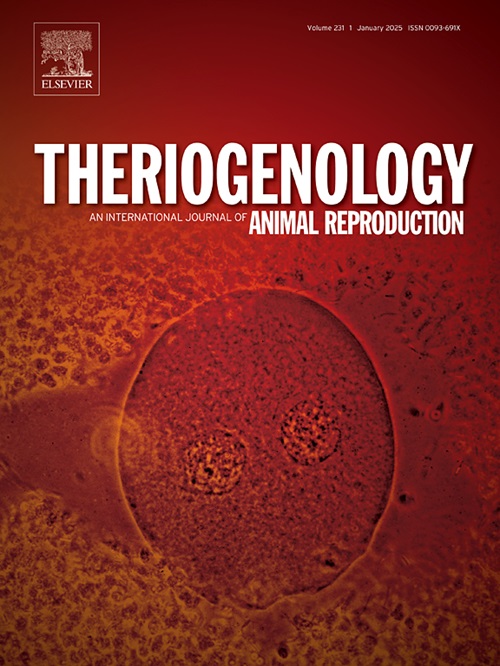融合对胚胎发育过程中的染色体重塑和细胞质分布
IF 2.4
2区 农林科学
Q3 REPRODUCTIVE BIOLOGY
引用次数: 0
摘要
细胞融合现在被广泛用作诱导和研究细胞命运变化的体外模型。在早期胚胎研究中,胚胎融合也是探索哺乳动物卵发生和着床前发育机制的一种方式。为了建立猪早期胚胎研究的新模型并探讨其发育机制,将一对无透明带(ZP)的卵母细胞电融合产生融合对(FP)胚胎,并将其体外培养至囊胚期。首先对其发育能力进行评估,发现其卵裂率为92.27±5.59%,囊胚率为26.12±6.61%,与孤雌生殖激活(PA)胚胎(p >;0.05)。随后,对14-22 h收集的FP胚胎进行核纺锤体染色,67.18±3.18%的胚胎发生纺锤体重组和细胞核融合,少数胚胎出现两核或三极纺锤体独立分裂。最后,用荧光染色法观察卵磷脂胚胎中脂滴(LDs)和线粒体的分布。结果表明,在4细胞至囊胚的每个卵裂球中,一个卵母细胞的LDs分布均匀。线粒体也有类似的分布模式,在2细胞阶段被观察到,这是一个相对早于LDs的发育阶段。结果表明,两个卵母细胞融合成单个胚胎后,包括线粒体和ld在内的细胞质可以重新分布。其潜在机制及其对FP胚胎发育能力的潜在影响有待进一步研究。本文章由计算机程序翻译,如有差异,请以英文原文为准。
Chromosome remodeling and cytoplasmic distribution during embryonic development in fused pair embryos
Cell fusion is now widely employed as an in vitro model for inducing and investigating cell fate changes. In early embryo research, fusion of embryos is also a way to probe the mechanisms of mammalian oogenesis and preimplantation development. To establish a novel model for porcine early embryo studies and investigate its developmental mechanisms, pair of zona pellucida (ZP)-free oocytes were electro fused to produce the fused pair (FP) embryos, which were further in vitro cultured to the blastocyst stage. Firstly, developmental competence was assessed, revealing a cleavage rate of 92.27 ± 5.59 % and a blastocyst rate of 26.12 ± 6.61 %, which were similar to the parthenogenetic activation (PA) embryos (p > 0.05). Subsequently, nuclear and spindle staining was performed on FP embryos collected at 14–22 h, with 67.18 ± 3.18 % of the embryos spindle reorganization occurred and nuclei fusion, whereas a few displayed independent division of the two nuclei or tripolar spindle. Lastly, the distribution of lipid droplets (LDs) and mitochondria in FP embryos was assessed via fluorescent staining. Results showed that the even distribution of LDs from one oocyte was observed in each blastomere of 4-cell to blastocysts. A similar distribution pattern was observed for mitochondria, which was being observed at the 2-cell stage, a relatively earlier developmental stage than that of LDs. Results suggested that cytoplasm including mitochondria and LDs could redistribute once two oocytes fused into a single embryo. More studies are needed for the underlying mechanism and potential impact on the developmental ability of FP embryos.
求助全文
通过发布文献求助,成功后即可免费获取论文全文。
去求助
来源期刊

Theriogenology
农林科学-生殖生物学
CiteScore
5.50
自引率
14.30%
发文量
387
审稿时长
72 days
期刊介绍:
Theriogenology provides an international forum for researchers, clinicians, and industry professionals in animal reproductive biology. This acclaimed journal publishes articles on a wide range of topics in reproductive and developmental biology, of domestic mammal, avian, and aquatic species as well as wild species which are the object of veterinary care in research or conservation programs.
 求助内容:
求助内容: 应助结果提醒方式:
应助结果提醒方式:


